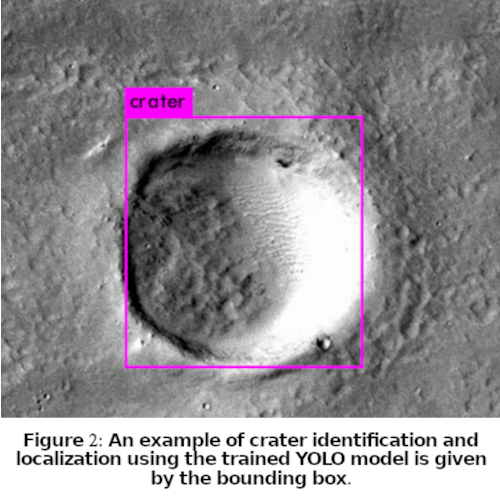An Object Detection Approach to Automatic Crater Detection from CTX Imagery
- 1Birla Institute of Technology and Science, Pilani, Hyderabad Campus (f20180243@hyderabad.bits-pilani.ac.in)
- 2Birla Institute of Technology and Science, Pilani, K.K. Birla Goa Campus, India (f20180093@goa.bits-pilani.ac.in)
- 3North Eastern Space Applications Centre, Department of Space, India (ritu.anilkumar@gmail.com)
ABSTRACT
Impact crater identification and localization are vital to age estimation studies of all planetary surfaces. This study illustrates the utility of object detection based approach for impact crater identification. We demonstrate this using the You Only Look Once (YOLO) object detection technique to localize and identify impact craters on the imagery from Context Camera onboard the Mars Reconnaissance Orbiter. The model was trained on a chipped and augmented dataset of 1450 images for 13000 iterations and tested on 750 images. Accuracy and sensitivity studies reveal a Mean Average Precision of 78.35%, precision of 0.81, recall (sensitivity) of 0.76 and F1 score of 0.78. We conclude that object detection techniques such as YOLO may be employed for crater counting studies and database generation.
INTRODUCTION
Cumulative crater size-frequency distribution studies have been widely used in establishing the age of planetary landforms [1,2]. The crater identification process for such studies has been largely manual wherein impact craters are digitized on GIS platforms. Recent studies have explored the potential of using automatic crater detection techniques such as Canny Edge Detection and Circular Hough Transform [3], machine learning classifiers such as random forest [4] and support vector machines [5], and deep learning-based semantic classification [6,7]. These techniques are often computationally intensive[6,7] or result in lower accuracy[3,4,5] values. We have implemented a different approach utilizing bounding box based object detection. Here, we present an automatic crater detection algorithm that utilizes the YOLO object detection technique[8] implemented on the Google Colaboratory cloud service platform.
DATA PREPARATION
15 datasets near the Hesperia Dorsa and Tartarus Montes regions of the Martian surface imaged by the Context Camera payload onboard the Mars Reconnaissance Orbiter satellite were used for our study. Impact craters larger than 50m were annotated as circles using the QGIS software and attributes of centroid coordinates, minimum and maximum annotation extents and diameter were extracted. Clusters of craters were identified using the Density-based spatial clustering of applications with noise(DBSCAN)[9] algorithm. 512x512 pixel image chips containing the crater clusters were extracted. A dataset of 528 image chips was generated after clustering and chipping. We next performed data augmentation using the Keras image data generator class and generated a dataset of 2200 images. This dataset was split into 2:1 train and test sets and used for training the darknet implementation of YOLO for the custom dataset.
OBJECT DETECTION
The darknet implementation of YOLO was used for object detection. The images were subjected to a convolutional neural network-based feature extraction utilizing the Relu activation. A learning rate of 0.001 was employed and the dataset was divided into batches of 64 images with a mini-batch size of 16. The model was trained for 16000 iterations using Google Colaboratory with a GPU hardware accelerator.
RESULTS
Results were validated by computing the Mean Average Precision (mAP) and F1 scores for the test set every 1000 iterations. Training for 13000 iterations has resulted in optimal F1 and mAP as evident from Figure 1. The average loss reduced to 0.235. The detection resulted in an F1 score of 0.78, mAP (for Intersection over Union of 0.5 and higher) of 78.35%, precision of 0.81 and recall of 0.76. The weights computed at the end of 13000 iterations were utilized for detection. A sample detection is depicted in Figure 2.

DISCUSSION
This study establishes the utility and compatibility of object detection algorithms such as YOLO for automatic crater detection. Improvements to the model can be attempted by incorporating multi-source detection and improving the number and variety of training samples. This technique can also be extended for use with existing global databases for a well-tuned pre-trained model which can be utilized by researchers for crater identification over any region of their study. Further, they can be useful in augmenting and updating planetary databases with minimal manual intervention.
REFERENCES
1. Ivanov, B. A., et al. "The comparison of size-frequency distributions of impact craters and asteroids and the planetary cratering rate." Asteroids III 1 (2002): 89-101.
2. Michael, G. G., and Gerhard Neukum. "Planetary surface dating from crater size-frequency distribution measurements: Partial resurfacing events and statistical age uncertainty." Earth and Planetary Science Letters 294.3-4 (2010): 223-229.
3. Galloway, M. J., et al. "Automated Crater Detection and Counting Using the Hough Transform and Canny Edge Detection." LPICo 1841 (2015): 9024.
4. Yin, Jihao, Hui Li, and Xiuping Jia. "Crater detection based on gist features." IEEE Journal of Selected Topics in Applied Earth Observations and Remote Sensing 8.1 (2014): 23-29.
5. Salamunićcar, Goran, and Sven Lončarić. "Application of machine learning using support vector machines for crater detection from Martian digital topography data." cosp 38 (2010): 3.
6. Silburt, Ari, et al. "Lunar crater identification via deep learning." Icarus 317 (2019): 27-38.
7. Lee, Christopher. "Automated crater detection on Mars using deep learning." Planetary and Space Science 170 (2019): 16-28.
8. Redmon, Joseph, et al. "You only look once: Unified, real-time object detection." Proceedings of the IEEE conference on computer vision and pattern recognition. 2016.
9. Ester, Martin, et al. "A density-based algorithm for discovering clusters in large spatial databases with noise." Kdd. Vol. 96. No. 34. 1996.
How to cite: Chaudhary, V., Mane, D., Anilkumar, R., Chouhan, A., Chutia, D., and Raju, P.: An Object Detection Approach to Automatic Crater Detection from CTX Imagery, Europlanet Science Congress 2020, online, 21 September–9 Oct 2020, EPSC2020-1029, https://doi.org/10.5194/epsc2020-1029, 2020

